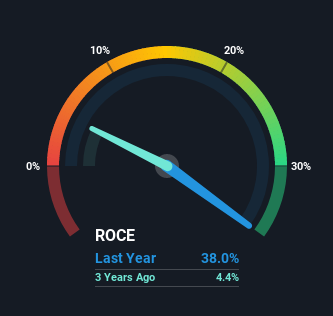Under The Bonnet, Tullow Oil's (LON:TLW) Returns Look Impressive
What trends should we look for it we want to identify stocks that can multiply in value over the long term? Ideally, a business will show two trends; firstly a growing return on capital employed (ROCE) and secondly, an increasing amount of capital employed. Basically this means that a company has profitable initiatives that it can continue to reinvest in, which is a trait of a compounding machine. With that in mind, the ROCE of Tullow Oil (LON:TLW) looks great, so lets see what the trend can tell us.
Understanding Return On Capital Employed (ROCE)
For those that aren't sure what ROCE is, it measures the amount of pre-tax profits a company can generate from the capital employed in its business. To calculate this metric for Tullow Oil, this is the formula:
Return on Capital Employed = Earnings Before Interest and Tax (EBIT) ÷ (Total Assets - Current Liabilities)
0.38 = US$1.8b ÷ (US$6.3b - US$1.6b) (Based on the trailing twelve months to June 2021).
Thus, Tullow Oil has an ROCE of 38%. In absolute terms that's a great return and it's even better than the Oil and Gas industry average of 3.7%.
See our latest analysis for Tullow Oil
Above you can see how the current ROCE for Tullow Oil compares to its prior returns on capital, but there's only so much you can tell from the past. If you'd like, you can check out the forecasts from the analysts covering Tullow Oil here for free.
What The Trend Of ROCE Can Tell Us
We're delighted to see that Tullow Oil is reaping rewards from its investments and has now broken into profitability. While the business is profitable now, it used to be incurring losses on invested capital five years ago. Additionally, the business is utilizing 52% less capital than it was five years ago, and taken at face value, that can mean the company needs less funds at work to get a return. Tullow Oil could be selling under-performing assets since the ROCE is improving.
For the record though, there was a noticeable increase in the company's current liabilities over the period, so we would attribute some of the ROCE growth to that. Essentially the business now has suppliers or short-term creditors funding about 26% of its operations, which isn't ideal. It's worth keeping an eye on this because as the percentage of current liabilities to total assets increases, some aspects of risk also increase.
The Key Takeaway
In a nutshell, we're pleased to see that Tullow Oil has been able to generate higher returns from less capital. And since the stock has dived 78% over the last five years, there may be other factors affecting the company's prospects. Regardless, we think the underlying fundamentals warrant this stock for further investigation.
One final note, you should learn about the 5 warning signs we've spotted with Tullow Oil (including 2 which are concerning) .
If you'd like to see other companies earning high returns, check out our free list of companies earning high returns with solid balance sheets here.
This article by Simply Wall St is general in nature. We provide commentary based on historical data and analyst forecasts only using an unbiased methodology and our articles are not intended to be financial advice. It does not constitute a recommendation to buy or sell any stock, and does not take account of your objectives, or your financial situation. We aim to bring you long-term focused analysis driven by fundamental data. Note that our analysis may not factor in the latest price-sensitive company announcements or qualitative material. Simply Wall St has no position in any stocks mentioned.
Have feedback on this article? Concerned about the content? Get in touch with us directly. Alternatively, email editorial-team (at) simplywallst.com.

